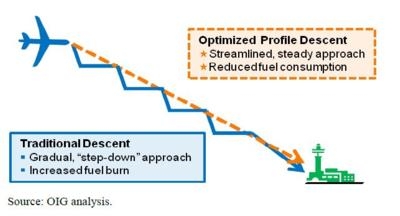Slow Implementation Of PBN Impeding Efficient Flow Of Traffic
A report released by the FAA Inspector General indicates that the agency FAA lacks the automated tools air traffic controllers need to increase performance-based navigation (PBN) use and achieve benefits.

According to the report a cornerstone of the FAA's Next Generation Air Transportation System is its initiative to enhance efficiency and capacity at airports through the use of PBN.
While FAA has deployed Time Based Flow Management (TBFM) — an automation tool to help controllers optimize PBN operations at high altitude — it has not effectively implemented TBFM or deployed a key tool to help optimize PBN operations near airports. In addition, TBFM is not adequately meeting controllers’ needs, due in part to a lack of training and coordination, and other longstanding problems. As a result, controllers have experienced significant operational problems that hinder systemwide use of the tool.
According to the report, the FAA is several years away from deploying a new controller automated tool for managing airport arrivals. FAA has not yet deployed a much needed tool to help controllers manage aircraft arrivals in the airspace closest to the busiest airports.
Advanced PBN procedures, such as RNP, allow more efficient approaches to runways, including curved paths. However, without an automated decision support tool for use in terminal airspace,17 controllers cannot effectively manage some aircraft arriving on straight-in approaches and others on curved PBN procedures. In addition, any efficiencies gained for PBN smoother descents at high altitude can be lost once aircraft enter the terminal airspace, as they will be forced to use costly level-offs (i.e., a “step-down” descent that requires more fuel). As figure 4 below illustrates, using a time-based tool for aircraft arrivals allows aircraft to fly shorter, more direct paths as they land.
The IG has made four recommendations to improve FAA’s implementation of controller automation tools and help optimize PBN operations. FAA concurred with three recommendations and partially concurred with one recommendation.
Those recommendations include:
- Establish firm milestones and follow through with all action items required to address TBFM Study Team report recommendations and a process to account for their completion.
- Prioritize actions needed to complete the implementation of enhancements, including Ground Interval Management-Spacing, Terminal Sequencing and Spacing, and Path Stretch which further facilitate PBN use.
- Establish a NAS-wide TBFM user collaboration and information sharing database or tracking system to capture lessons learned by facilities and subject matter experts during TBFM implementation and use.
- Establish a process for creating agreements (e.g., Letters of Agreement), including corresponding procedures, between facilities to accommodate wider use of automation tools and establish a target date for implementing them.

The OIG says the FAA concurred with recommendations 1, 3, and 4, agreed to implement them as written, and provided appropriate target action dates.
FAA partially concurred with recommendation 2 because the Agency believes it has processes for prioritization in place, but agrees that additional collaboration is needed with the user community to expedite PBN use. FAA stated that it will provide an update on this collaboration by December 31, 2015.
In addition, FAA stated that it would provide a detailed response to all four recommendations at a later date. "Based on FAA’s response, we consider three recommendations resolved but open, and one recommendation unresolved pending receipt of an update from the Agency," the report states.
 ANN's Daily Aero-Linx (04.15.24)
ANN's Daily Aero-Linx (04.15.24) Classic Aero-TV: 'No Other Options' -- The Israeli Air Force's Danny Shapira
Classic Aero-TV: 'No Other Options' -- The Israeli Air Force's Danny Shapira Aero-News: Quote of the Day (04.15.24)
Aero-News: Quote of the Day (04.15.24) Airborne 04.16.24: RV Update, Affordable Flying Expo, Diamond Lil
Airborne 04.16.24: RV Update, Affordable Flying Expo, Diamond Lil ANN's Daily Aero-Term (04.16.24): Chart Supplement US
ANN's Daily Aero-Term (04.16.24): Chart Supplement US




